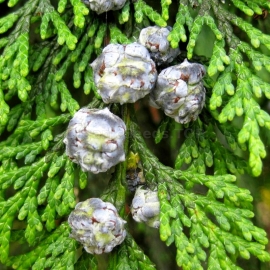




Organic Lawson cypress Seeds (Chamaecyparis Lawsoniana)
1.14 €
Lawson's cypress make an excellent hedge of all heights, they are very tolerant of clipping so long as this does not extend into the brown barked wood since trees cannot regenerate from this. Any trimming should be done in the summer.
-
Organic Scots Pine (Pinus Sylvestris L.)
Few trees get more overlooked than this one, most people take one look and assume it's a leylandii. It is however a large and quite majestic tree if given a chance to grow beyond the reach of the hedge clippers.
Native to Oregon and the far north west of California where it can grow to 200 feet tall or more, with trunks 4-6 feet in diameter. It is a species capable of enormous natural variation and has spawned many hundreds of different cultivars that are grown in gardens throughout the world
Lawson's cypress make an excellent hedge of all heights, they are very tolerant of clipping so long as this does not extend into the brown barked wood since trees cannot regenerate from this. Any trimming should be done in the summer. They are less vigorous than the excellent but over planted leylandii.
Succeeds in most soils and situations, but prefers a moist deep loamy soil and a sheltered position. Can grows well in heavy clay soils and alkaline soils. Tolerates moderate wind exposure but not severe maritime exposure.
Like most conifers these seeds have a shallow dormancy of around 30 days which is quite easy to break. An information sheet on the germination, sowing and after care of these seeds will be sent with every order.
How to Grow
Lawson's cypress seeds are relatively easy to germinate and grow. The dormancy within the seed is short and easily broken. This is achieved by a short period of cold stratification in the fridge. You can do this by first soaking the seeds in water for 24 hours. Fully drain away all of the water and place the seeds in a zip-lock freezer bag.
Place the seeds in the fridge, it is important that during this period that the seeds do not dry out or are waterlogged otherwise the pre-treatment will be ineffective. After 4 weeks under these conditions the seeds are ready to be sown. In general, many seeds will fail to germinate unless treated in this way, simply sowing untreated seeds in compost at room temperature will not break down the dormancy and germination will be disappointing.
Fill your chosen container with a good quality general potting compost. Suitable containers could be plant pots, seed trays or plug trays or even improvised containers with drainage holes. Firm the compost gently and sow the seeds on the surface. If you are sowing in plug trays, sow 2 or 3 seeds per cell. Cover the seeds with a couple of millimetres of vermiculite or failing that a fine layer of sieved compost.
Follow with a gentle watering and keep them at room temperature. Germination will begin a few weeks from sowing. The seedlings are reasonably robust and trouble free and usually grow to a height of between 2 and 4 cm in the first growing season depending on the sowing date and cultural techniques.
Developing seedlings should be fine in full sun, keep them well watered and free of competing weeds. The seedlings first leaves resemble short needles, once the seedling has developed sufficiently and is perhaps between 3 and 5 cm tall it will begin to produce the flattened foliage fronds normally associated with this species.
Growth will accelerate in the second and subsequent years and the developing young trees should be re-potted as necessary preferably during the dormant season. After perhaps 2 or 3 years they are ready to be planted in their permanent position
